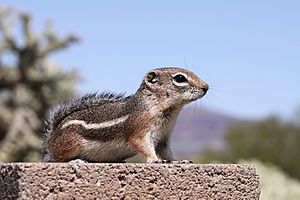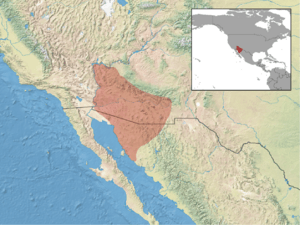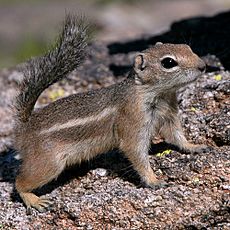Harris's antelope squirrel facts for kids
Quick facts for kids Harris's antelope squirrel |
|
|---|---|
 |
|
| Conservation status | |
| Scientific classification | |
 |
The Harris's antelope squirrel (Ammospermophilus harrisii) is a small, quick rodent that belongs to the squirrel family. You can find these active creatures in the hot deserts of Arizona and New Mexico in the United States, and in Sonora, Mexico. They are super good at living in warm places, even using a special trick called "heat dumping" to stay cool. These squirrels eat many different things, from plants and seeds to insects and even small animals.
Contents
Meet the Harris's Antelope Squirrel
This squirrel is named after a person called Edward Harris. Harris's antelope squirrels have special markings on their fur. They have grey fur with brown parts on their sides and legs. A clear white stripe runs down each side of their body, and they also have white rings around their eyes.
Their fur changes with the seasons. It grows longer and thicker in the winter to keep them warm. In the summer, it becomes shorter. Adult squirrels usually weigh about 4 to 5 ounces (113 to 142 grams). Their body is about 8.5 to 10 inches (22 to 25 cm) long, not counting their tail. Their tail adds another 3 to 4 inches (8 to 10 cm) to their length. Sometimes, people might mistake them for chipmunks because they look a bit similar.
Staying Cool in the Desert Heat
Harris's antelope squirrels have a naturally high body temperature, usually between 97 and 107 degrees Fahrenheit (36.7 and 41.6 °C). This helps them stay active even when it's hot. To protect themselves from the intense heat of the Sonoran Desert, they use a clever trick. They hold their bushy tails over their bodies like an umbrella to create shade.
They also have a special way to cool down called "heat dumping." When they get too warm, they find a shady spot and lie flat on the cool ground. They spread their bodies out to let the heat escape into the ground. These squirrels are active during the day. They don't sweat like humans, but they can cool down by salivating, which means they produce more spit.
Life Cycle and Reproduction
The best time for Harris's antelope squirrels to have babies is between February and March. However, they can mate anytime from December to June. After mating, the mother squirrel is pregnant for about 30 days.
Female squirrels usually have one litter of pups each year. On average, a litter has about 6 or 7 baby squirrels. These newborns grow up quickly, reaching their adult size around 217 days after they are born. Both male and female squirrels can start having their own babies when they are about one year old.
Where They Live and What They Eat
Harris's antelope squirrels live in the southwestern parts of the United States. You can find them mainly in Arizona and the southwest of New Mexico. Their home also extends south into the northwest part of Sonora, Mexico.
Their diet is quite varied. They enjoy eating the fruit and seeds from local cactus plants. They also like the beans from the mesquite plant. But they don't just eat plants! These squirrels also munch on insects, small rodents, and even carrion (the meat of dead animals).
Many different animals hunt Harris's antelope squirrels. Their predators include animals like the bobcat and coyote. Snakes in the area also hunt them. Even domestic animals like dogs and cats can be a danger to them. While these squirrels are not currently endangered, their natural homes are shrinking because of human developments.
See also
 In Spanish: Ammospermophilus harrisii para niños
In Spanish: Ammospermophilus harrisii para niños



